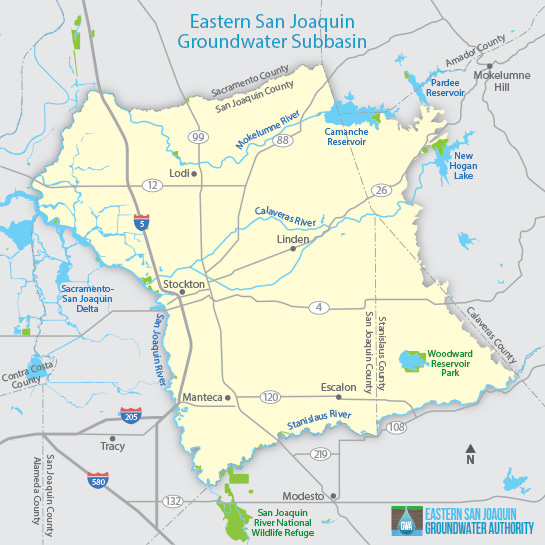What area does the Eastern Groundwater Authority represent?
The Eastern San Joaquin Groundwater Authority represents the area overlying the Eastern San Joaquin groundwater subbasin, as designated by DWR. The area includes portions of San Joaquin, Stanislaus, and Calaveras counties. The subbasin is bounded by the San Joaquin River to the west, the Sierra Nevada foothills to the east, Dry Creek to the north, and the Stanislaus River to the south.

What is the Authority’s purpose?
The Eastern San Joaquin Groundwater Authority was established as a public entity with the mission of providing dynamic, cost-effective, flexible and collegial organization to insure initial and ongoing SGMA compliance within the Basin. Its purpose is to:
-
Provide coordination among its 17 Groundwater Sustainability Agency members
-
Carry out SGMA purposes in a cooperative manner
-
Develop, adopt and implement a legally sufficient Groundwater Sustainability Plan that covers portions of the subbasin within the jurisdictional boundaries
-
Satisfy SGMA’s requirements for coordination among the Groundwater Sustainability Agencies
Who are the members of the Authority?
The member of the Authority are 17 Groundwater Sustainability Agencies located in the Eastern San Joaquin Subbasin. Members include:
-
Calaveras County Water District
-
Central Delta Water Agency
-
Central San Joaquin Water Conservation District
-
City of Lathrop
-
City of Lodi
-
City of Manteca
-
City of Stockton
-
Eastside San Joaquin Groundwater Sustainability Agency
-
Linden County Water District
-
Lockeford Community Services District
-
North San Joaquin Water Conservation District
-
Oakdale Irrigation District
-
San Joaquin County
-
South Delta Water Agency
-
South San Joaquin Groundwater Sustainability Agency
-
Stockton East Water District
-
Woodbridge Irrigation District Groundwater Sustainability Agency
What is a Groundwater Sustainability Agency?
A Groundwater Sustainability Agency is one or more local governmental agencies that implement the provisions of SGMA. A local agency is defined as one that has water supply, water management or land management authority. GSAs assess the conditions of their local basins, adopt locally-based sustainable management plans to create drought resiliency, and improve coordination between land use and groundwater planning.
What is SGMA?
The Sustainable Groundwater Management Act, signed into law in 2014, provides a framework for long-term sustainable groundwater management across California. It requires that local and regional authorities in the medium- and high-priority groundwater basins form a locally-controlled and governed Groundwater Sustainability Agency (GSA), which will prepare and implement a Groundwater Sustainability Plan (GSP).
What is a Groundwater Sustainability Plan?
A GSP is the plan of a GSA that provides for sustainably managed groundwater that meets the requirements of SGMA. GSAs in high and medium priority groundwater basins are required to submit a GSP to the California Department of Water Resources. The plan must outline how the GSA will implement, manage and measure specific actions for the health and viability of the basins. DWR will evaluate the GSP and provide the GSA with an assessment of the plan and any necessary recommendations every two years following its establishment.
How can I learn more?
How can I get involved in the plan development?
Where can I view a map of the ESJ Groundwater Sustainability Agencies?
What costs are associated with forming and administering a GSA?
Forming a GSA, then developing and implementing a Groundwater Sustainability Plan (GSP), require both start-up and ongoing costs. As part of the GSA formation, agencies determine how to share costs for developing the GSP and may also take advantage of grants and other funding opportunities, such as Proposition 1 bond funds, to help create and implement a GSP.